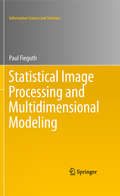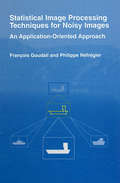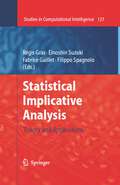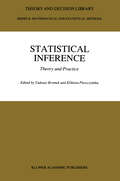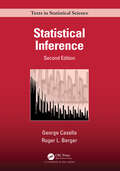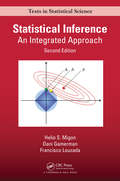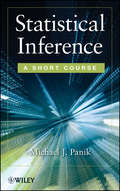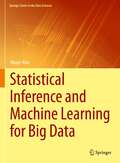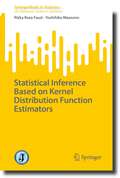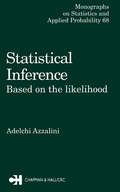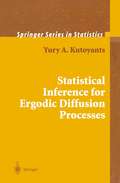- Table View
- List View
Statistical Image Processing and Multidimensional Modeling (Information Science and Statistics)
by Paul FieguthImages are all around us! The proliferation of low-cost, high-quality imaging devices has led to an explosion in acquired images. When these images are acquired from a microscope, telescope, satellite, or medical imaging device, there is a statistical image processing task: the inference of something—an artery, a road, a DNA marker, an oil spill—from imagery, possibly noisy, blurry, or incomplete. A great many textbooks have been written on image processing. However this book does not so much focus on images, per se, but rather on spatial data sets, with one or more measurements taken over a two or higher dimensional space, and to which standard image-processing algorithms may not apply. There are many important data analysis methods developed in this text for such statistical image problems. Examples abound throughout remote sensing (satellite data mapping, data assimilation, climate-change studies, land use), medical imaging (organ segmentation, anomaly detection), computer vision (image classification, segmentation), and other 2D/3D problems (biological imaging, porous media). The goal, then, of this text is to address methods for solving multidimensional statistical problems. The text strikes a balance between mathematics and theory on the one hand, versus applications and algorithms on the other, by deliberately developing the basic theory (Part I), the mathematical modeling (Part II), and the algorithmic and numerical methods (Part III) of solving a given problem. The particular emphases of the book include inverse problems, multidimensional modeling, random fields, and hierarchical methods.
Statistical Image Processing Techniques for Noisy Images: An Application-Oriented Approach
by Phillipe Réfrégier François GoudailStatistical Processing Techniques for Noisy Images presents a statistical framework to design algorithms for target detection, tracking, segmentation and classification (identification). Its main goal is to provide the reader with efficient tools for developing algorithms that solve his/her own image processing applications. In particular, such topics as hypothesis test-based detection, fast active contour segmentation and algorithm design for non-conventional imaging systems are comprehensively treated, from theoretical foundations to practical implementations. With a large number of illustrations and practical examples, this book serves as an excellent textbook or reference book for senior or graduate level courses on statistical signal/image processing, as well as a reference for researchers in related fields.
Statistical Implications of Turing's Formula
by Zhiyi ZhangFeatures a broad introduction to recent research on Turing’s formula and presents modern applications in statistics, probability, information theory, and other areas of modern data science Turing's formula is, perhaps, the only known method for estimating the underlying distributional characteristics beyond the range of observed data without making any parametric or semiparametric assumptions. This book presents a clear introduction to Turing’s formula and its connections to statistics. Topics with relevance to a variety of different fields of study are included such as information theory; statistics; probability; computer science inclusive of artificial intelligence and machine learning; big data; biology; ecology; and genetics. The author provides examinations of many core statistical issues within modern data science from Turing's perspective. A systematic approach to long-standing problems such as entropy and mutual information estimation, diversity index estimation, domains of attraction on general alphabets, and tail probability estimation is presented in light of the most up-to-date understanding of Turing's formula. Featuring numerous exercises and examples throughout, the author provides a summary of the known properties of Turing's formula and explains how and when it works well; discusses the approach derived from Turing's formula in order to estimate a variety of quantities, all of which mainly come from information theory, but are also important for machine learning and for ecological applications; and uses Turing's formula to estimate certain heavy-tailed distributions. In summary, this book: • Features a unified and broad presentation of Turing’s formula, including its connections to statistics, probability, information theory, and other areas of modern data science • Provides a presentation on the statistical estimation of information theoretic quantities • Demonstrates the estimation problems of several statistical functions from Turing's perspective such as Simpson's indices, Shannon's entropy, general diversity indices, mutual information, and Kullback–Leibler divergence • Includes numerous exercises and examples throughout with a fundamental perspective on the key results of Turing’s formula Statistical Implications of Turing's Formula is an ideal reference for researchers and practitioners who need a review of the many critical statistical issues of modern data science. This book is also an appropriate learning resource for biologists, ecologists, and geneticists who are involved with the concept of diversity and its estimation and can be used as a textbook for graduate courses in mathematics, probability, statistics, computer science, artificial intelligence, machine learning, big data, and information theory. Zhiyi Zhang, PhD, is Professor of Mathematics and Statistics at The University of North Carolina at Charlotte. He is an active consultant in both industry and government on a wide range of statistical issues, and his current research interests include Turing's formula and its statistical implications; probability and statistics on countable alphabets; nonparametric estimation of entropy and mutual information; tail probability and biodiversity indices; and applications involving extracting statistical information from low-frequency data space. He earned his PhD in Statistics from Rutgers University.
Statistical Implications of Turing's Formula
by Zhiyi ZhangFeatures a broad introduction to recent research on Turing’s formula and presents modern applications in statistics, probability, information theory, and other areas of modern data science Turing's formula is, perhaps, the only known method for estimating the underlying distributional characteristics beyond the range of observed data without making any parametric or semiparametric assumptions. This book presents a clear introduction to Turing’s formula and its connections to statistics. Topics with relevance to a variety of different fields of study are included such as information theory; statistics; probability; computer science inclusive of artificial intelligence and machine learning; big data; biology; ecology; and genetics. The author provides examinations of many core statistical issues within modern data science from Turing's perspective. A systematic approach to long-standing problems such as entropy and mutual information estimation, diversity index estimation, domains of attraction on general alphabets, and tail probability estimation is presented in light of the most up-to-date understanding of Turing's formula. Featuring numerous exercises and examples throughout, the author provides a summary of the known properties of Turing's formula and explains how and when it works well; discusses the approach derived from Turing's formula in order to estimate a variety of quantities, all of which mainly come from information theory, but are also important for machine learning and for ecological applications; and uses Turing's formula to estimate certain heavy-tailed distributions. In summary, this book: • Features a unified and broad presentation of Turing’s formula, including its connections to statistics, probability, information theory, and other areas of modern data science • Provides a presentation on the statistical estimation of information theoretic quantities • Demonstrates the estimation problems of several statistical functions from Turing's perspective such as Simpson's indices, Shannon's entropy, general diversity indices, mutual information, and Kullback–Leibler divergence • Includes numerous exercises and examples throughout with a fundamental perspective on the key results of Turing’s formula Statistical Implications of Turing's Formula is an ideal reference for researchers and practitioners who need a review of the many critical statistical issues of modern data science. This book is also an appropriate learning resource for biologists, ecologists, and geneticists who are involved with the concept of diversity and its estimation and can be used as a textbook for graduate courses in mathematics, probability, statistics, computer science, artificial intelligence, machine learning, big data, and information theory. Zhiyi Zhang, PhD, is Professor of Mathematics and Statistics at The University of North Carolina at Charlotte. He is an active consultant in both industry and government on a wide range of statistical issues, and his current research interests include Turing's formula and its statistical implications; probability and statistics on countable alphabets; nonparametric estimation of entropy and mutual information; tail probability and biodiversity indices; and applications involving extracting statistical information from low-frequency data space. He earned his PhD in Statistics from Rutgers University.
Statistical Implicative Analysis: Theory and Applications (Studies in Computational Intelligence)
by Régis Gras Einoshin Suzuki Fabrice Guillet Filippo SpagnoloStatistical implicative analysis is a data analysis method created by Régis Gras almost thirty years ago which has a significant impact on a variety of areas ranging from pedagogical and psychological research to data mining. Statistical implicative analysis (SIA) provides a framework for evaluating the strength of implications; such implications are formed through common knowledge acquisition techniques in any learning process, human or artificial. This new concept has developed into a unifying methodology, and has generated a powerful convergence of thought between mathematicians, statisticians, psychologists, specialists in pedagogy and last, but not least, computer scientists specialized in data mining. This volume collects significant research contributions of several rather distinct disciplines that benefit from SIA. Contributions range from psychological and pedagogical research, bioinformatics, knowledge management, and data mining.
Statistical Inference: Theory and Practice (Theory and Decision Library B #17)
by Tadeusz Bromek Elzbieta PleszczynskaUse and misuse of statistics seems to be the signum temporis of past decades. But nowadays this practice seems slowly to be wearing away, and common sense and responsibility recapturing their position. It is our contention that little by little statistics should return to its starting point, i.e., to formalizing and analyzing empirical phenomena. This requires the reevalu ation of many traditions and the rejection of many myths. We hope that our book would go some way towards this aim. We show the sharp conflict between what is needed and what is feasible. Moreover, we show how slender are the links between theory and practice in statistical inference, links which are sometimes no more than mutual inspiration. In Part One we present the consecutive stages of formalization of statistical problems, i.e., the description of the experiment, the presentation of the aim of the investigation, and of the constraints put upon the decision rules. We stress the fact that at each of these stages there is room for arbitrariness. We prove that the links between the real problem and its formal counterpart are often so weak that the solution of the formal problem may have no rational interpretation at the practical level. We give a considerable amount of thought to the reduction of statistical problems.
Statistical Inference (Chapman & Hall/CRC Texts in Statistical Science)
by George Casella Roger BergerThis classic textbook builds theoretical statistics from the first principles of probability theory. Starting from the basics of probability, the authors develop the theory of statistical inference using techniques, definitions, and concepts that are statistical and natural extensions, and consequences, of previous concepts. It covers all topics from a standard inference course including: distributions, random variables, data reduction, point estimation, hypothesis testing, and interval estimation. Features The classic graduate-level textbook on statistical inference Develops elements of statistical theory from first principles of probability Written in a lucid style accessible to anyone with some background in calculus Covers all key topics of a standard course in inference Hundreds of examples throughout to aid understanding Each chapter includes an extensive set of graduated exercises Statistical Inference, Second Edition is primarily aimed at graduate students of statistics, but can be used by advanced undergraduate students majoring in statistics who have a solid mathematics background. It also stresses the more practical uses of statistical theory, being more concerned with understanding basic statistical concepts and deriving reasonable statistical procedures, while less focused on formal optimality considerations.This is a reprint of the second edition originally published by Cengage Learning, Inc. in 2001.
Statistical Inference (Chapman & Hall/CRC Texts in Statistical Science)
by George Casella Roger BergerThis classic textbook builds theoretical statistics from the first principles of probability theory. Starting from the basics of probability, the authors develop the theory of statistical inference using techniques, definitions, and concepts that are statistical and natural extensions, and consequences, of previous concepts. It covers all topics from a standard inference course including: distributions, random variables, data reduction, point estimation, hypothesis testing, and interval estimation. Features The classic graduate-level textbook on statistical inference Develops elements of statistical theory from first principles of probability Written in a lucid style accessible to anyone with some background in calculus Covers all key topics of a standard course in inference Hundreds of examples throughout to aid understanding Each chapter includes an extensive set of graduated exercises Statistical Inference, Second Edition is primarily aimed at graduate students of statistics, but can be used by advanced undergraduate students majoring in statistics who have a solid mathematics background. It also stresses the more practical uses of statistical theory, being more concerned with understanding basic statistical concepts and deriving reasonable statistical procedures, while less focused on formal optimality considerations.This is a reprint of the second edition originally published by Cengage Learning, Inc. in 2001.
Statistical Inference: An Integrated Approach, Second Edition (Chapman And Hall/crc Texts In Statistical Science Ser.)
by Helio S. Migon Dani Gamerman Francisco LouzadaA Balanced Treatment of Bayesian and Frequentist InferenceStatistical Inference: An Integrated Approach, Second Edition presents an account of the Bayesian and frequentist approaches to statistical inference. Now with an additional author, this second edition places a more balanced emphasis on both perspectives than the first edition.New to the Sec
Statistical Inference: A Short Course
by Michael J. PanikA concise, easily accessible introduction to descriptive and inferential techniques Statistical Inference: A Short Course offers a concise presentation of the essentials of basic statistics for readers seeking to acquire a working knowledge of statistical concepts, measures, and procedures. The author conducts tests on the assumption of randomness and normality, provides nonparametric methods when parametric approaches might not work. The book also explores how to determine a confidence interval for a population median while also providing coverage of ratio estimation, randomness, and causality. To ensure a thorough understanding of all key concepts, Statistical Inference provides numerous examples and solutions along with complete and precise answers to many fundamental questions, including: How do we determine that a given dataset is actually a random sample? With what level of precision and reliability can a population sample be estimated? How are probabilities determined and are they the same thing as odds? How can we predict the level of one variable from that of another? What is the strength of the relationship between two variables? The book is organized to present fundamental statistical concepts first, with later chapters exploring more advanced topics and additional statistical tests such as Distributional Hypotheses, Multinomial Chi-Square Statistics, and the Chi-Square Distribution. Each chapter includes appendices and exercises, allowing readers to test their comprehension of the presented material. Statistical Inference: A Short Course is an excellent book for courses on probability, mathematical statistics, and statistical inference at the upper-undergraduate and graduate levels. The book also serves as a valuable reference for researchers and practitioners who would like to develop further insights into essential statistical tools.
Statistical Inference: A Short Course
by Michael J. PanikA concise, easily accessible introduction to descriptive and inferential techniques Statistical Inference: A Short Course offers a concise presentation of the essentials of basic statistics for readers seeking to acquire a working knowledge of statistical concepts, measures, and procedures. The author conducts tests on the assumption of randomness and normality, provides nonparametric methods when parametric approaches might not work. The book also explores how to determine a confidence interval for a population median while also providing coverage of ratio estimation, randomness, and causality. To ensure a thorough understanding of all key concepts, Statistical Inference provides numerous examples and solutions along with complete and precise answers to many fundamental questions, including: How do we determine that a given dataset is actually a random sample? With what level of precision and reliability can a population sample be estimated? How are probabilities determined and are they the same thing as odds? How can we predict the level of one variable from that of another? What is the strength of the relationship between two variables? The book is organized to present fundamental statistical concepts first, with later chapters exploring more advanced topics and additional statistical tests such as Distributional Hypotheses, Multinomial Chi-Square Statistics, and the Chi-Square Distribution. Each chapter includes appendices and exercises, allowing readers to test their comprehension of the presented material. Statistical Inference: A Short Course is an excellent book for courses on probability, mathematical statistics, and statistical inference at the upper-undergraduate and graduate levels. The book also serves as a valuable reference for researchers and practitioners who would like to develop further insights into essential statistical tools.
Statistical Inference
by S.D. SilveyStatistics is a subject with a vast field of application, involving problems which vary widely in their character and complexity.However, in tackling these, we use a relatively small core of central ideas and methods. This book attempts to concentrateattention on these ideas: they are placed in a general settingand illustrated by relatively simple examples, avoidingwherever possible the extraneous difficulties of complicatedmathematical manipulation.In order to compress the central body of ideas into a smallvolume, it is necessary to assume a fair degree of mathematicalsophistication on the part of the reader, and the book is intendedfor students of mathematics who are already accustomed tothinking in rather general terms about spaces and functions
Statistical Inference
by S.D. SilveyStatistics is a subject with a vast field of application, involving problems which vary widely in their character and complexity.However, in tackling these, we use a relatively small core of central ideas and methods. This book attempts to concentrateattention on these ideas: they are placed in a general settingand illustrated by relatively simple examples, avoidingwherever possible the extraneous difficulties of complicatedmathematical manipulation.In order to compress the central body of ideas into a smallvolume, it is necessary to assume a fair degree of mathematicalsophistication on the part of the reader, and the book is intendedfor students of mathematics who are already accustomed tothinking in rather general terms about spaces and functions
Statistical Inference and Machine Learning for Big Data (Springer Series in the Data Sciences)
by Mayer AlvoThis book presents a variety of advanced statistical methods at a level suitable for advanced undergraduate and graduate students as well as for others interested in familiarizing themselves with these important subjects. It proceeds to illustrate these methods in the context of real-life applications in a variety of areas such as genetics, medicine, and environmental problems. The book begins in Part I by outlining various data types and by indicating how these are normally represented graphically and subsequently analyzed. In Part II, the basic tools in probability and statistics are introduced with special reference to symbolic data analysis. The most useful and relevant results pertinent to this book are retained. In Part III, the focus is on the tools of machine learning whereas in Part IV the computational aspects of BIG DATA are presented. This book would serve as a handy desk reference for statistical methods at the undergraduate and graduate level as well as be useful in courses which aim to provide an overview of modern statistics and its applications.
Statistical Inference and Probability (The SAGE Quantitative Research Kit)
by John MacInnesAn experienced author in the field of data analytics and statistics, John Macinnes has produced a straight-forward text that breaks down the complex topic of inferential statistics with accessible language and detailed examples. It covers a range of topics, including: · Probability and Sampling distributions · Inference and regression · Power, effect size and inverse probability Part of The SAGE Quantitative Research Kit, this book will give you the know-how and confidence needed to succeed on your quantitative research journey.
Statistical Inference and Probability (The SAGE Quantitative Research Kit)
by John MacInnesAn experienced author in the field of data analytics and statistics, John Macinnes has produced a straight-forward text that breaks down the complex topic of inferential statistics with accessible language and detailed examples. It covers a range of topics, including: · Probability and Sampling distributions · Inference and regression · Power, effect size and inverse probability Part of The SAGE Quantitative Research Kit, this book will give you the know-how and confidence needed to succeed on your quantitative research journey.
Statistical Inference and Probability (The SAGE Quantitative Research Kit)
by John MacInnesAn experienced author in the field of data analytics and statistics, John Macinnes has produced a straight-forward text that breaks down the complex topic of inferential statistics with accessible language and detailed examples. It covers a range of topics, including: · Probability and Sampling distributions · Inference and regression · Power, effect size and inverse probability Part of The SAGE Quantitative Research Kit, this book will give you the know-how and confidence needed to succeed on your quantitative research journey.
Statistical Inference Based on Kernel Distribution Function Estimators (SpringerBriefs in Statistics)
by Rizky Reza Fauzi Yoshihiko MaesonoThis book presents a study of statistical inferences based on the kernel-type estimators of distribution functions. The inferences involve matters such as quantile estimation, nonparametric tests, and mean residual life expectation, to name just some. Convergence rates for the kernel estimators of density functions are slower than ordinary parametric estimators, which have root-n consistency. If the appropriate kernel function is used, the kernel estimators of the distribution functions recover the root-n consistency, and the inferences based on kernel distribution estimators have root-n consistency. Further, the kernel-type estimator produces smooth estimation results. The estimators based on the empirical distribution function have discrete distribution, and the normal approximation cannot be improved—that is, the validity of the Edgeworth expansion cannot be proved. If the support of the population density function is bounded, there is a boundary problem, namely the estimator does not have consistency near the boundary. The book also contains a study of the mean squared errors of the estimators and the Edgeworth expansion for quantile estimators.
Statistical Inference Based on the likelihood
by Adelchi AzzaliniThe Likelihood plays a key role in both introducing general notions of statistical theory, and in developing specific methods. This book introduces likelihood-based statistical theory and related methods from a classical viewpoint, and demonstrates how the main body of currently used statistical techniques can be generated from a few key concepts, in particular the likelihood.Focusing on those methods, which have both a solid theoretical background and practical relevance, the author gives formal justification of the methods used and provides numerical examples with real data.
Statistical Inference Based on the likelihood (Monographs On Statistics And Applied Probability #Vol. 68)
by Adelchi AzzaliniThe Likelihood plays a key role in both introducing general notions of statistical theory, and in developing specific methods. This book introduces likelihood-based statistical theory and related methods from a classical viewpoint, and demonstrates how the main body of currently used statistical techniques can be generated from a few key concepts, in particular the likelihood.Focusing on those methods, which have both a solid theoretical background and practical relevance, the author gives formal justification of the methods used and provides numerical examples with real data.
Statistical Inference, Econometric Analysis and Matrix Algebra: Festschrift in Honour of Götz Trenkler
by Bernhard Schipp Walter KrämerThis Festschrift is dedicated to Götz Trenkler on the occasion of his 65th birthday. As can be seen from the long list of contributions, Götz has had and still has an enormous range of interests, and colleagues to share these interests with. He is a leading expert in linear models with a particular focus on matrix algebra in its relation to statistics. He has published in almost all major statistics and matrix theory journals. His research activities also include other areas (like nonparametrics, statistics and sports, combination of forecasts and magic squares, just to mention afew). Götz Trenkler was born in Dresden in 1943. After his school years in East G- many and West-Berlin, he obtained a Diploma in Mathematics from Free University of Berlin (1970), where he also discovered his interest in Mathematical Statistics. In 1973, he completed his Ph.D. with a thesis titled: On a distance-generating fu- tion of probability measures. He then moved on to the University of Hannover to become Lecturer and to write a habilitation-thesis (submitted 1979) on alternatives to the Ordinary Least Squares estimator in the Linear Regression Model, a topic that would become his predominant ?eld of research in the years to come.
Statistical Inference for Discrete Time Stochastic Processes (SpringerBriefs in Statistics)
by M. B. RajarshiThis work is an overview of statistical inference in stationary, discrete time stochastic processes. Results in the last fifteen years, particularly on non-Gaussian sequences and semi-parametric and non-parametric analysis have been reviewed. The first chapter gives a background of results on martingales and strong mixing sequences, which enable us to generate various classes of CAN estimators in the case of dependent observations. Topics discussed include inference in Markov chains and extension of Markov chains such as Raftery's Mixture Transition Density model and Hidden Markov chains and extensions of ARMA models with a Binomial, Poisson, Geometric, Exponential, Gamma, Weibull, Lognormal, Inverse Gaussian and Cauchy as stationary distributions. It further discusses applications of semi-parametric methods of estimation such as conditional least squares and estimating functions in stochastic models. Construction of confidence intervals based on estimating functions is discussed in some detail. Kernel based estimation of joint density and conditional expectation are also discussed. Bootstrap and other resampling procedures for dependent sequences such as Markov chains, Markov sequences, linear auto-regressive moving average sequences, block based bootstrap for stationary sequences and other block based procedures are also discussed in some detail. This work can be useful for researchers interested in knowing developments in inference in discrete time stochastic processes. It can be used as a material for advanced level research students.
Statistical Inference for Ergodic Diffusion Processes (Springer Series in Statistics)
by Yury A. KutoyantsThe first book in inference for stochastic processes from a statistical, rather than a probabilistic, perspective. It provides a systematic exposition of theoretical results from over ten years of mathematical literature and presents, for the first time in book form, many new techniques and approaches.
Statistical Inference for Financial Engineering (SpringerBriefs in Statistics)
by Masanobu Taniguchi Tomoyuki Amano Hiroaki Ogata Hiroyuki TaniaiThis monograph provides the fundamentals of statistical inference for financial engineering and covers some selected methods suitable for analyzing financial time series data. In order to describe the actual financial data, various stochastic processes, e.g. non-Gaussian linear processes, non-linear processes, long-memory processes, locally stationary processes etc. are introduced and their optimal estimation is considered as well. This book also includes several statistical approaches, e.g., discriminant analysis, the empirical likelihood method, control variate method, quantile regression, realized volatility etc., which have been recently developed and are considered to be powerful tools for analyzing the financial data, establishing a new bridge between time series and financial engineering.This book is well suited as a professional reference book on finance, statistics and statistical financial engineering. Readers are expected to have an undergraduate-level knowledge of statistics.
Statistical Inference for Fractional Diffusion Processes (Wiley Series In Probability And Statistics Ser. #901)
by B. L. RaoStochastic processes are widely used for model building in the social, physical, engineering and life sciences as well as in financial economics. In model building, statistical inference for stochastic processes is of great importance from both a theoretical and an applications point of view. This book deals with Fractional Diffusion Processes and statistical inference for such stochastic processes. The main focus of the book is to consider parametric and nonparametric inference problems for fractional diffusion processes when a complete path of the process over a finite interval is observable. Key features: Introduces self-similar processes, fractional Brownian motion and stochastic integration with respect to fractional Brownian motion. Provides a comprehensive review of statistical inference for processes driven by fractional Brownian motion for modelling long range dependence. Presents a study of parametric and nonparametric inference problems for the fractional diffusion process. Discusses the fractional Brownian sheet and infinite dimensional fractional Brownian motion. Includes recent results and developments in the area of statistical inference of fractional diffusion processes. Researchers and students working on the statistics of fractional diffusion processes and applied mathematicians and statisticians involved in stochastic process modelling will benefit from this book.
